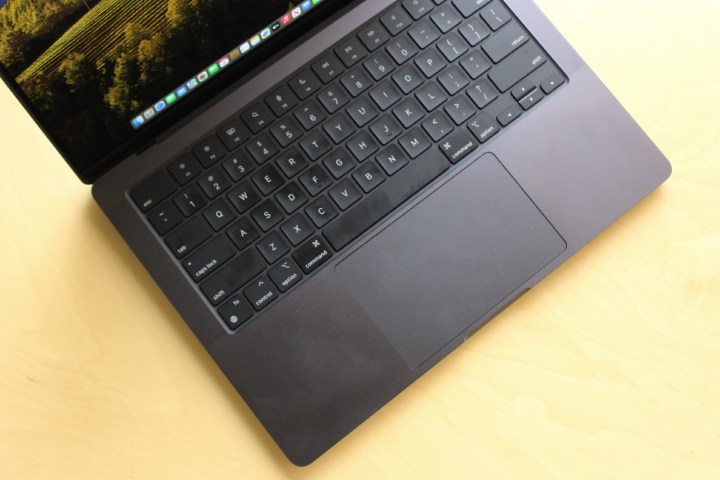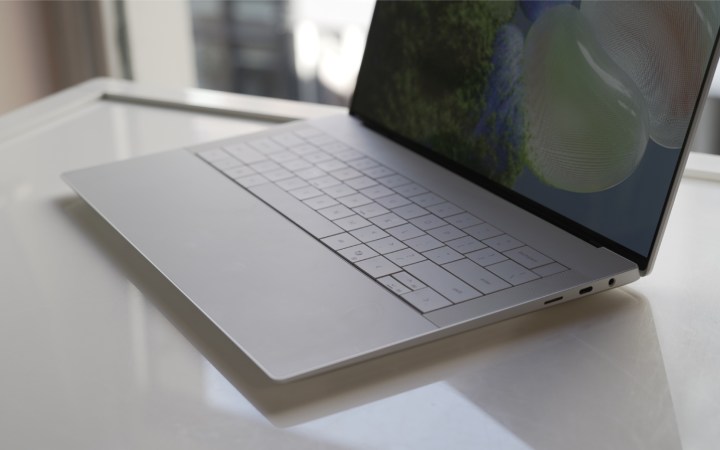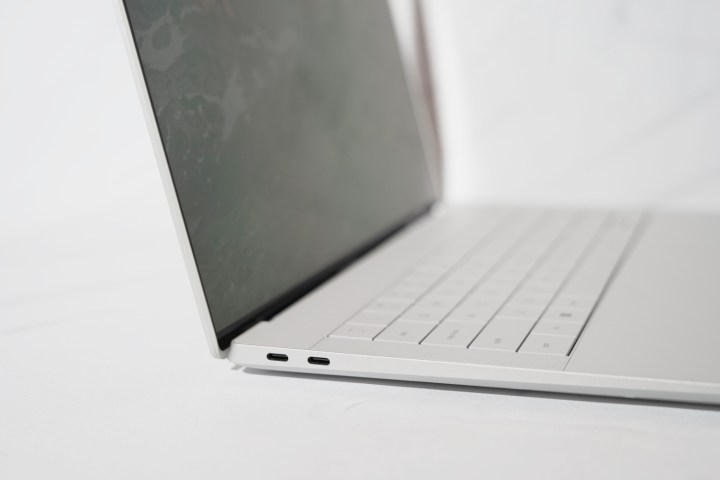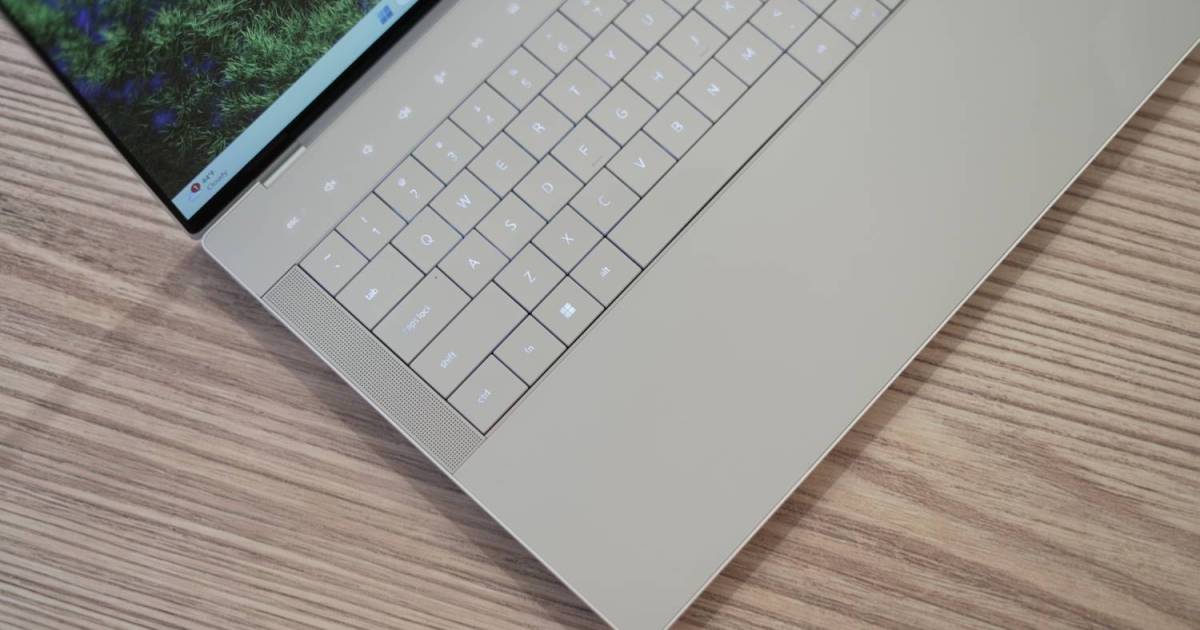Heading into CES 2024, Dell has a completely new lineup of XPS laptops, including an XPS 13 that looks like the XPS 13 Plus, an XPS 14, and an XPS 16.
The XPS 14 is arguably the most exciting of the bunch in many ways, but it’s running smack-dab into the Apple MacBook Pro 14 that has dominated the segment since its introduction in 2021. Can Dell’s latest offering take over as the best 14-inch laptop? Not so fast.
Specs and configurations
| Dell XPS 14 | Apple MacBook Pro 14 | |
| Dimensions | 12.6 inches x 8.5 inches x 0.71 inches | 12.31 inches x 8.71 inches x 0.60 inches |
| Weight | 3.8 pounds | 3.5 pounds |
| Processor | Intel Core Ultra 7 155H Intel Core Ultra 7 165H |
Apple M3 (8-core) Apple M3 Pro (11-core, 12-core) Apple M3 Max (14-core, 16-core) |
| Graphics | Intel Arc Nvidia GeForce RTX 4050 |
10-core GPU 14-core GPU 18-core GPU 30-core GPU 40-core GPU |
| RAM | 16GB 32GB 64GB |
8GB 16GB 32GB 64GB 96GB 128GB |
| Display | 14.5-inch FHD+ (1,920 x 1,200) IPS non-touch, 120Hz 14.5-inch 3.2K (3,200 x 2,000) OLED touch, 120Hz |
14.2-inch 16:10 Liquid Retina XDR 3024 x 1964, 120Hz |
| Storage | 512GB SSD 1TB SSD 2TB SSD 4TB SSD |
512GB SSD 1TB SSD 2TB SSD 4TB SSD 8TB SSD |
| Touch | Optional | No |
| Ports | 3 x USB-C with Thunderbolt 4 1 x 3.5mm audio jack MicroSD card reader |
2 x USB-C with Thunderbolt 4 (M3) 3 x USB-C with Thunderbolt 4 (M3 Pro/Max) 1 x HDMI 2.0 1 x 3.5mm audio jack SD card reader |
| Wireless | Wi-Fi 6E and Bluetooth 5.3 | Wi-Fi 6E and Bluetooth 5.3 |
| Webcam | 1080p with infrared camera for Windows Hello | 1080p |
| Operating system | Windows 11 | macOS Sonoma |
| Battery | 69.5 watt-hour | 72.4 watt-hour |
| Price | $1,700+ | $1,999+ |
| Rating | Not yet review | 4.5 out of 5 stars |
We don’t have full pricing yet for the XPS 14. It starts at $1,700, presumably for the entry-level configuration of an Intel Core Ultra 155H, 16GB of RAM, a 512GB SSD, Intel Arc graphics, and a 14.5-inch FHD+ IPS display. That means that more powerful configurations will likely be more than $3,000.
The MacBook Pro 14 is a little less expensive at $1,599 for the base configuration with an Apple M3, 8GB of RAM, a 512GB SSD, and a 14.2-inch mini-LED display. When fully configured similarly, the two laptops are a close match in terms of price — though the MacBook Pro can be maxed out with a far more powerful and expensive configuration with an M3 Max, 128GB of RAM, and an 8TB SSD.
The MacBook Pro 14 will likely be the pricier laptop at the high end, albeit with twice the RAM and storage.
Design

The XPS 14 is a brand-new laptop, slotting between the new XPS 13 and XPS 16 models as a compromise between screen size and portability. Even with a slightly larger display, the XPS is a bit wider and a bit shallower than the MacBook Pro 14. The MacBook is quite a bit thinner and not a little less than half a pound lighter.
In terms of its aesthetic, the XPS 14 is a thoroughly modern laptop. Its CNC-machined lid and chassis come in light and dark color schemes with anodized chrome around the edges. Open it up, and the glass palm rest with a seamless touchpad, color-coded keyboard, and LED function keys presents a unique look.
The MacBook Pro 14 is more simplistic, with a Space Gray or Midnight Black CNC-machined lid and chassis forming a more minimalist, exquisitely elegant appearance. Both laptops are great to look at, and while we haven’t handled the XPS 14 yet, the line’s build quality has always matched that of Apple’s MacBooks. That means both will be solidly built and will feel comfortably dense in hand.

The XPS 14’s keyboard has large keycaps that are closely spaced, and we’re guessing that it uses the same excellent switches as the XPS 13 Plus. That makes it a close match to the Magic Keyboard on the MacBook Pro 14, which has the best keyboard available on a laptop today. The Magic Keyboard also has large keycaps and sports perfect key spacing, and its switches are light and snappy.
The XPS 14 has a hidden haptic touchpad that promises to work well if it’s similar to the one on the XPS 13 Plus, while the MacBook Pro 14’s Force Touch haptic touchpad is practically perfect.
Connectivity favors the MacBook Pro 14, which has an HDMI port to go with its Thunderbolt 4 connections (although the XPS 14 has one more Thunderbolt 4 port than the M3 MacBook Pro 14). We also prefer the full-sized SD card reader in the MacBook over the XPS 14’s microSD reader. Both laptops have Wi-Fi 6E with Bluetooth 5.3.
The XPS 14 has an infrared camera that supports Windows 11 Hello facial recognition and a fingerprint reader in the power button. The MacBook Pro 14 has a Touch ID sensor in its power button.
Finally, both laptops have 1080p webcams, and both should provide excellent image quality for videoconferencing.
The XPS 14 features user presence sensing technology, which can detect when the user leaves, locking the laptop and putting it to sleep, and waking it up and logging back in when the user returns. Microsoft’s Copilot AI assistant tool is now featured more prominently with a dedicated Copilot key on the keyboard. The MacBook Pro 14 lacks these features.
Performance

As we can see in the benchmarks below, the M3 Max is significantly faster than the Core Ultra 7 155H in the Swift Go 14 that we used as a proxy for the XPS 14, particularly in multicore applications. The XPS 14 will compete better with the base M3 MacBook Pro 14.
The XPS 15 features Intel’s Arc graphics chip, which is a significant upgrade compared to the Intel Iris Xe integrated graphics, along with an Nvidia GeForce RTX 4050 option. We’ll have to wait to test the laptop’s graphics performance to compare it to the MacBook Pro 14, but Apple’s chipset will likely be significantly faster in creative applications that can use the GPU. The Meteor Lake chipset also adds a dedicated Neural Processing Unit (NPU), matching the NPU in Apple Silicon. Further testing will be required to see if Intel’s NPU can keep up with Apple’s in AI-enabled apps and processes.
| Geekbench 6 single/multi |
Cinebench R23 single/multi | |
| Acer Swift Go 14 (Core Ultra 7 155H) |
1,831 / 8,959 | 1762 / 10773 |
| Apple MacBook Pro 14 (M3 Max) |
3,174 / 21,137 | 1,881 / 22,028 |
Display and audio

The XPS 14 comes with two display options: a 14.5-inch FHD+ IPS panel running at up to 120Hz and a 3.2K OLED display at up to 120Hz. The former will enable improved battery life, while the latter will provide OLED’s usual inky blacks and spectacular colors. We haven’t tested the XPS 14 yet, but we imagine both displays will be excellent examples of their respective technologies.
The MacBook Pro 14 comes with a single display, a 14.2-inch mini-LED panel that offers incredible brightness both in standard dynamic range (SDR) at up to 600 nits and high dynamic range (HDR) at up to a blinding 1,600 nits. In our testing, the display offered wide, accurate colors and deep contrast that rival OLED and offers even better HDR performance.
The MacBook Pro 14’s display is one of the best on a laptop today. Dell has its work cut out if it wants to win this category, though we’re delighted to see them move to 120Hz panels.
The same goes for audio, where the MacBook Pro 14 has six speakers with force-canceling woofers pumping out some of the best sound available. The XPS 14 has quad speakers with Waves MaxxAudio Pro tuning. We’ll have to wait to test the XPS 14 to testify to its audio quality.
Portability

Both laptops are roughly the same size and weight, with a slight nod to the MacBook Pro 14. You’ll feel both in your backpack more than with 13-inch machines but certainly a lot less than with their 16-inch equivalents.
But portability is about more than thickness and weight. Battery life also matters, and the MacBook Pro 14 will likely provide significantly better battery life. Apple’s M3 chips are incredibly efficient, and the MacBook Pro 14 will last you a full day and keep going into the following day as well. Intel’s Meteor Lake chips are intended to be more efficient, but we’ll be surprised if the XPS 14 lasts as long.
The XPS 14 is fighting an uphill battle
The XPS 14 looks like an outstanding new 14-inch laptop, offering a thoroughly modern design, excellent components, and solid productivity performance. We’ll have to wait for our review to be sure just how good it really is.
But unless the XPS 14 surprises us with its performance and battery life, it will have a rough row to hoe in going up against the MacBook Pro 14. Apple’s laptop offers superb creativity performance, superior battery life, and the best mini-LED display available on a laptop. It’s really hard to beat.
Editors’ Recommendations







)